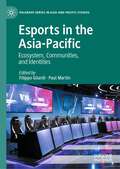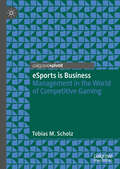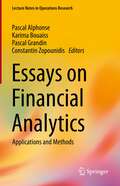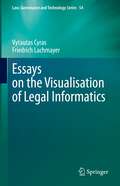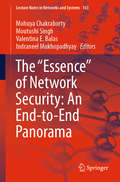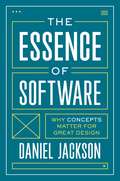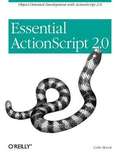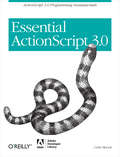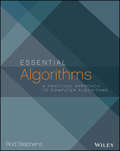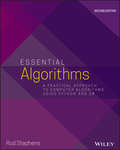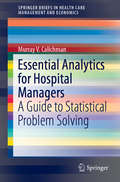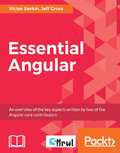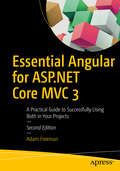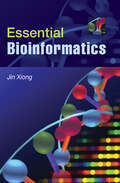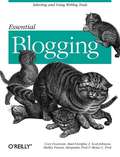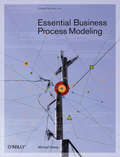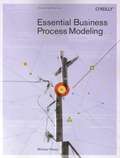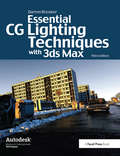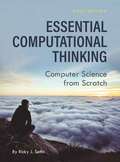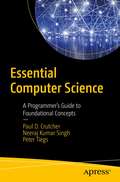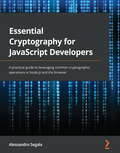- Table View
- List View
Esports in the Asia-Pacific: Ecosystem, Communities, and Identities (Palgrave Series in Asia and Pacific Studies)
by Filippo Gilardi Paul MartinThis is an edited book that fills a gap in knowledge by providing a comprehensive view of esports practice from the Asia and Pacific region. The volume looks at the development of esports through the interconnections between institutions, industries, players, and society, across the Asia-Pacific. Over the last two decades, the Asia-Pacific region has been central to the growth and development of esports. The value of this book lies in its ability to provide a view of esport from countries that are currently underrepresented in the literature such as Vietnam, Malaysia, Taiwan, Hong Kong, Singapore, Philippines and Australia while still integrating chapters looking at more well-researched countries such as China, Korea, and Japan. Through its diverse case studies, the book serves as a resource for scholars and educators worldwide who seek diverse examples with which to improve understanding of the esports phenomenon and the inclusiveness of media and communication curricula. chapters “Introduction to Esports in the Asia-Pacific” and “Conclusions to Esports in the Asia–Pacific” are available open access under a Creative Commons Attribution 4.0 International License via link.springer.com.
eSports is Business: Management in the World of Competitive Gaming
by Tobias M. ScholzThe global phenomenon of eSports has experienced exponential growth in recent years, gaining interest from the media, sports and technology industries. Being born digital, global and agile, competitive gaming appeals to a young and emerging audience, and therefore the management of businesses within the eSports industry requires a unique strategy. Presenting a short history of the industry and an overview of its various stakeholders, the author explores how important governing principles have emerged to culminate in a business model network. An insightful read for scholars researching innovation, eBusiness and strategy, this book takes a pioneering approach and examines potential implications for the future of eSports.
Essays on Financial Analytics: Applications and Methods (Lecture Notes in Operations Research)
by Pascal Alphonse Karima Bouaiss Pascal Grandin Constantin ZopounidisThis book covers recent research advances, methods and techniques, applications and projects in financial analytics, with a focus on the effects of the health crisis on banking activities and financial engineering. It explores the latest developments in banking regulation, banking and financial systems, financial engineering, and corporate finance in order to provide financial analytics that assess financial stability and sustainability. Written for researchers and practitioners alike, the book is intended to promote stimulating scientific exchanges, ideas and experiences in the field of financial analytics for economics and management.
Essays on the Visualisation of Legal Informatics (Law, Governance and Technology Series #54)
by Vytautas Cyras Friedrich LachmayerBoth legal scholars and computer scientists will be curious to know how the gap between law and computing can be bridged. The law, and also jurisprudence, is based on language, and is mainly textual. Every syntactic system has its semantic range, and so does language, which in law achieves a high degree of professional precision. The use of visualisations is a syntactic supplement and opens up a new understanding of legal forms. This understanding was reinforced by the paradigm shift from textual law to legal informatics, in which visual formal notations are decisive. The authors have been dealing with visualisation approaches for a long time and summarise them here for discussion. In this book, a multiphase transformation from the legal domain to computer code is explored. The authors consider law enforcement by computer. The target view is that legal machines are legal actors that are capable of triggering institutional facts. In the visualisation of statutory law, an approach called Structural Legal Visualisation is presented. Specifically, the visualisation of legal meaning is linked with tertium comparationis, the third part of the comparison. In a legal documentation system, representing one legal source with multiple documents is viewed as a granularity problem. The authors propose to supplement legislative documents ex ante with explicit logic-oriented information in the form of a mini thesaurus. In contrast to so-called strong relations such as synonymy, antonymy and hypernymy/hyponymy, one should consider weak relations: (1) dialectical relations, a term of dialectical antithesis; (2) context relations; and (3) metaphorical relations, which means the use of metaphors for terms. The chapters trace topics such as the distinction between knowledge visualisation and knowledge representation, the visualisation of Hans Kelsen’s Pure Theory of Law, the separation of law and legal science, legal subsumption, legal relations, legal machines, encapsulation, compliance, transparency, standard cases and hard cases.
The "Essence" of Network Security: An End-to-End Panorama (Lecture Notes in Networks and Systems #163)
by Mohuya Chakraborty Moutushi Singh Valentina E. Balas Indraneel MukhopadhyayThis edited book provides an optimal portrayal of the principles and applications related to network security. The book is thematically divided into five segments: Part A describes the introductory issues related to network security with some concepts of cutting-edge technologies; Part B builds from there and exposes the readers to the digital, cloud and IoT forensics; Part C presents readers with blockchain and cryptography techniques; Part D deals with the role of AI and machine learning in the context of network security. And lastly, Part E is written on different security networking methodologies. This is a great book on network security, which has lucid and well-planned chapters. All the latest security technologies are thoroughly explained with upcoming research issues. Details on Internet architecture, security needs, encryption, cryptography along with the usages of machine learning and artificial intelligence for network security are presented in a single cover. The broad-ranging text/reference comprehensively surveys network security concepts, methods, and practices and covers network security policies and goals in an integrated manner. It is an essential security resource for practitioners in networks and professionals who develop and maintain secure computer networks.
The Essence of Photography
by Bruce BarnbaumThere is a lot more to photography than simply picking up a camera, pointing it toward something, and tripping the shutter. Achieving a great photograph requires thought and preparation, an understanding of the photographic process, and a firm grasp of how light and composition affect a photo. There must be personal involvement and personal expression. There must be experimentation, with the recognition that only a small percentage of experiments end successfully.In this book, best-selling author and world-renowned photographer and teacher Bruce Barnbaum explores these seldom-discussed issues by drawing upon his personal experiences and observations from more than 40 years of photographing and teaching. In addition to photographs, Bruce also uses painting, music, and writing, as well as the sciences and even business, to provide pertinent examples of creative thinking. These examples serve as stepping-stones that will lead you to your own heightened ability to see and be creative.Creativity is a topic that is almost wholly ignored in formal education because most instructors think that it cannot be taught or learned. To the contrary, Bruce has proven that photographic seeing and creativity can be taught, learned, and improved. This book expands on the ideas that are central to Bruce's method of teaching photography, which he has used in workshops for the past 41 years.Included in the book are in-depth discussions on the following topics:Defining your own unique rhythm and approach as a photographerHow to translate the scene in front of you to the final photographThe differences and similarities between how an amateur and a professional approach photographyThe differences between realism and abstraction, and the possibilities and limitations of eachLearning to expand your own seeing and creativity through classes, workshops, and associating with other photographersWhy the rules of composition should be ignoredHow to follow your passionWhen to listen to the critics and when to ignore themThe book is richly illustrated with over 90 photographs taken by Bruce as well as other photographers.Seeing and creativity are difficult to teach, but not impossible. This very different, perhaps groundbreaking book is sure to inspire photographers of all skill levels-from beginners to seasoned professionals-to think deeply about the issues involved in creating successful photographs.
The Essence of Software: Why Concepts Matter for Great Design
by Daniel JacksonA revolutionary concept-based approach to thinking about, designing, and interacting with softwareAs our dependence on technology increases, the design of software matters more than ever before. Why then is so much software flawed? Why hasn’t there been a systematic and scalable way to create software that is easy to use, robust, and secure?Examining these issues in depth, The Essence of Software introduces a theory of software design that gives new answers to old questions. Daniel Jackson explains that a software system should be viewed as a collection of interacting concepts, breaking the functionality into manageable parts and providing a new framework for thinking about design. Through this radical and original perspective, Jackson lays out a practical and coherent path, accessible to anyone—from strategist and marketer to UX designer, architect, or programmer—for making software that is empowering, dependable, and a delight to use.Jackson explores every aspect of concepts—what they are and aren’t, how to identify them, how to define them, and more—and offers prescriptive principles and practical tips that can be applied cost-effectively in a wide range of domains. He applies these ideas to contemporary software designs, drawing examples from leading software manufacturers such as Adobe, Apple, Dropbox, Facebook, Google, Microsoft, Twitter, and others. Jackson shows how concepts let designers preserve and reuse design knowledge, rather than starting from scratch in every project.An argument against the status quo and a guide to improvement for both working designers and novices to the field, The Essence of Software brings a fresh approach to software and its creation.
Essential ActionScript 2.0
by Colin MoockIn Essential ActionScript 2.0 , bestselling author Colin Moock covers everything you'll need to know about the new ActionScript language and its methodologies. Experienced Flash developers and programmers coming from other languages will enjoy the sheer depth of Moocks's coverage. Novice programmers will appreciate the frequent, low-jargon explanations that are often glossed over by advanced programming books. Essential ActionScript 2.0 is the one book every ActionScript coder must own.
Essential ActionScript 3.0
by Colin MoockActionScript 3.0 is a huge upgrade to Flash's programming language. The enhancements to ActionScript's performance, feature set, ease of use, cleanliness, and sophistication are considerable. Essential ActionScript 3.0 focuses on the core language and object-oriented programming, along with the Flash Player API. Essential ActionScript has become the #1 resource for the Flash and ActionScript development community, and the reason is the author, Colin Moock. Many people even refer to it simply as "The Colin Moock book." And for good reason: No one is better at turning ActionScript inside out, learning its nuances and capabilities, and then explaining everything in such an accessible way. Colin Moock is not just a talented programmer and technologist; he's also a gifted teacher. Essential ActionScript 3.0 is a radically overhauled update to Essential ActionScript 2.0. True to its roots, the book once again focuses on the core language and object-oriented programming, but also adds a deep look at the centerpiece of Flash Player's new API: display programming. Enjoy hundreds of brand new pages covering exciting new language features, such as the DOM-based event architecture, E4X, and namespaces--all brimming with real-world sample code. The ActionScript 3.0 revolution is here, and Essential ActionScript 3.0's steady hand is waiting to guide you through it. Adobe Developer Library is a co-publishing partnership between O'Reilly Media and Adobe Systems, Inc. and is designed to produce the number one information resources for developers who use Adobe technologies. Created in 2006, the Adobe Developer Library is the official source for comprehensive learning solutions to help developers create expressive and interactive web applications that can reach virtually anyone on any platform. With top-notch books and innovative online resources covering the latest in rich Internet application development, the Adobe Developer Library offers expert training and in-depth resources, straight from the source.
Essential Algorithms
by Rod StephensA friendly and accessible introduction to the most useful algorithmsComputer algorithms are the basic recipes for programming. Professional programmers need to know how to use algorithms to solve difficult programming problems. Written in simple, intuitive English, this book describes how and when to use the most practical classic algorithms, and even how to create new algorithms to meet future needs. The book also includes a collection of questions that can help readers prepare for a programming job interview. Reveals methods for manipulating common data structures such as arrays, linked lists, trees, and networksAddresses advanced data structures such as heaps, 2-3 trees, B-treesAddresses general problem-solving techniques such as branch and bound, divide and conquer, recursion, backtracking, heuristics, and moreReviews sorting and searching, network algorithms, and numerical algorithms Includes general problem-solving techniques such as brute force and exhaustive search, divide and conquer, backtracking, recursion, branch and bound, and moreIn addition, Essential Algorithms features a companion website that includes full instructor materials to support training or higher ed adoptions.
Essential Algorithms: A Practical Approach to Computer Algorithms Using Python and C#
by Rod StephensA friendly introduction to the most useful algorithms written in simple, intuitive English The revised and updated second edition of Essential Algorithms, offers an accessible introduction to computer algorithms. The book contains a description of important classical algorithms and explains when each is appropriate. The author shows how to analyze algorithms in order to understand their behavior and teaches techniques that the can be used to create new algorithms to meet future needs. The text includes useful algorithms such as: methods for manipulating common data structures, advanced data structures, network algorithms, and numerical algorithms. It also offers a variety of general problem-solving techniques. In addition to describing algorithms and approaches, the author offers details on how to analyze the performance of algorithms. The book is filled with exercises that can be used to explore ways to modify the algorithms in order to apply them to new situations. This updated edition of Essential Algorithms: Contains explanations of algorithms in simple terms, rather than complicated math Steps through powerful algorithms that can be used to solve difficult programming problems Helps prepare for programming job interviews that typically include algorithmic questions Offers methods can be applied to any programming language Includes exercises and solutions useful to both professionals and students Provides code examples updated and written in Python and C# Essential Algorithms has been updated and revised and offers professionals and students a hands-on guide to analyzing algorithms as well as the techniques and applications. The book also includes a collection of questions that may appear in a job interview. The book’s website will include reference implementations in Python and C# (which can be easily applied to Java and C++).
Essential Analytics for Hospital Managers: A Guide to Statistical Problem Solving (SpringerBriefs in Health Care Management and Economics)
by Murray V. CalichmanThis book provides practical applications of statistical and mathematical concepts to resolve common issues in hospital management. Each chapter discusses a key component of hospital operations, such as maximizing hospital profitability through pricing optimization, forecasting facility requirements from historical data, and determining optimal patient schedules to fully utilize hospital resources in order to eliminate over-crowding in the emergency department. Structured by the degree of mathematical complexity, this professional book utilizes problem-solving methodologies ranging from basic statistical concepts (means and standard deviations) to more advanced statistics (Poisson distributions and queuing theory). Concluding with computer applications and simulations, the practical examples will help hospital managers to optimally and innovatively make use of linear programming. The book’s main goal is to make hospital personnel more aware of the benefits of management science methodologies that are not usually employed in today’s hospitals.
Essential Angular
by Victor Savkin Jeff CrossEssential Angular is a concise, complete overview of the key aspects of Angular, written by two Angular core contributors. The book covers the framework's mental model, its API, and the design principles behind it. It is fully up to date with the latest release of Angular. About This Book • Written by two Angular core contributors • A complete overview of the key aspects of Angular • Up to date with the latest Angular release Who This Book Is For To get the most from this book, you should already have a good understanding of Angular and general web development. The book dives quickly into the core Angular systems without stepping through the basics. What You Will Learn • Understand why and how to use JIT and AOT compilation in Angular • Bootstrap and inject NgModules • Learn about the component lifecycle • Understand the two phases of Change Detection • Visualize and parse the Injector tree • Understand advanced Lazy Loading • Integrate and run different testing strategies on your code In Detail Essential Angular is a concise, complete overview of the key aspects of Angular, written by two Angular core contributors. The book covers the framework's mental model, its API, and the design principles behind it. This book is fully up to date with the latest release of Angular. Essential Angular gives you a strong foundation in the core Angular technology. It will help you put all the concepts into the right places so you will have a good understanding of why the framework is the way it is. Read this book after you have toyed around with the framework, but before you embark on writing your first serious Angular application. This book covers concepts such as the differences between Just-In-Time (JIT) and Ahead-Of-Time (AOT) compilation in Angular, alongside NgModules, components and directives. It also goes into detail on Dependency Injection and Change Detection: essential skills for Angular developers to master. The book finishes with a look at testing, and how to integrate different testing methodologies in your Angular code. Style and approach Essential Angular is a complete overview of the key aspects of the latest release of Angular, written by two core Angular contributors. It goes far beyond a how-to-get-started guide and dives into the most important topics in modern Angular development at depth.
Essential Angular for ASP.NET Core MVC 3: A Practical Guide to Successfully Using Both in Your Projects
by Adam FreemanCombine the strengths of Angular, the leading framework for developing complex client-side applications, and ASP.NET Core MVC 3, the latest evolution of Microsoft’s framework for server-side applications. This new edition offers updated Angular, ASP.NET Core 3, Entity Framework Core 3 examples, an all-new chapter on interoperability with Blazor, and more! Best-selling author Adam Freeman brings together these two key technologies and explains how to use ASP.NET Core MVC 3 to provide back-end services for Angular applications. This fast-paced and practical guide starts from the nuts and bolts and gives you the knowledge you need to combine Angular and ASP.NET Core MVC 3 in your projects. Each topic is covered clearly and concisely and is packed with the essential details you need to learn to be truly effective. What You Will Learn Gain a solid understanding of how ASP.NET Core MVC 3 and Angular can work together Utilize both Visual Studio and Visual Studio Code to develop Angular/ASP.NET Core MVC projects Create ASP.NET Core RESTful web services to support Angular applications Expose data from Entity Framework Core to Angular applications Use ASP.NET Core Identity to provide security services to Angular applications Understand how Angular and Blazor applications can work together Who This Book Is ForThis book is for developers with knowledge of ASP.NET Core MVC who are introducing Angular into their projects.
Essential ASP.NET Web Forms Development: Full Stack Programming with C#, SQL, Ajax, and JavaScript
by Robert E. BeasleyGo from beginner to pro using one of the most effective and widely used technology stacks, Microsoft ASP.NET. Beginning with the basics, you will learn how to create interactive, professional-grade, database-driven web applications in no time, using ASP.NET, C#, SQL, Ajax, and JavaScript.Essential ASP.NET Web Forms Development is divided into six learning modules and will take you from soup to nuts with ASP.NET. Part I is an introduction to the major concepts, methodologies, and technologies associated with .NET web application development. You will learn about the client-server model, the .NET Framework, the ASP.NET and C# programming languages, and the Visual Studio integrated development environment. Part II teaches you how to develop a single-page .NET web application and add server and data validation controls, laying the foundation for learning languages in the context of an ASP.NET web application. Part III is all about C# operations and shows you how to perform assignment operations, conversion operations, control operations, string operations, arithmetic operations, date and time operations, array operations, collection operations, and file system operations, as well as create custom C# classes in the context of a .NET web application. In Part IV, you dive into a multiple-page .NET web application and learn how to maintain state between pages and create master pages, themes, and navigation controls. Part V shows you how to connect a .NET web application to a SQL Server database. You will learn to read a database schema, program in the SQL language, utilize data binding, perform single- and multiple-row database table maintenance, and write code behind database operations. And finally, Part VI teaches you how to enhance the interactivity of a .NET web application. You will learn how to generate email messages, make use of basic Ajax controls and the Ajax Control Toolkit, and program in the JavaScript language. What You Will Learn Delve into the basics of the client-server model, the .NET Framework, the ASP.NET and C# programming languages, and the Visual Studio integrated development environmentCreate a page and add server and data validation controlsDevelop basic programming skills in the C# languageMaintain state between pages and create master pages, themes, and navigation controlsRead a database schema, program in the SQL language, utilize data binding, perform single- and multiple-row database table maintenance, and write code behind database operationsGenerate email messages, make use of basic Ajax controls and the Ajax Control Toolkit, and program in the JavaScript language Who This Book Is ForAnyone who wants to learn how to build ASP.NET web applications. Basic computer skills and the use of a database management system are recommended. Instructor materials and examples are available.
Essential Bioinformatics
by Jin XiongEssential Bioinformatics is a concise yet comprehensive textbook of bioinformatics, which provides a broad introduction to the entire field. Written specifically for a life science audience, the basics of bioinformatics are explained, followed by discussions of the state-of-the-art computational tools available to solve biological research problems. All key areas of bioinformatics are covered including biological databases, sequence alignment, genes and promoter prediction, molecular phylogenetics, structural bioinformatics, genomics and proteomics. The book emphasizes how computational methods work and compares the strengths and weaknesses of different methods. This balanced yet easily accessible text will be invaluable to students who do not have sophisticated computational backgrounds. Technical details of computational algorithms are explained with a minimum use of mathematical formulae; graphical illustrations are used in their place to aid understanding. The effective synthesis of existing literature as well as in-depth and up-to-date coverage of all key topics in bioinformatics make this an ideal textbook for all bioinformatics courses taken by life science students and for researchers wishing to develop their knowledge of bioinformatics to facilitate their own research.
Essential Blogging
by Cory Doctorow Rael Dornfest J. E. Johnson Shelley Powers Benjamin Trott Mena G. TrottWith weblogs or "blogs" exploding all over the Web, the only thing lacking for power users and developers is detailed advice on how choose, install, and run blogging software. Written by leading bloggers, Essential Bloggingincludes practical advice and insider tips on the features, requirements, and limitations of applications such as Blogger, Radio Userland, Movable Type, and Blosxom. This book will get you up and blogging in no time.
Essential Business Process Modeling
by Michael HaveyTen years ago, groupware bundled with email and calendar applications helped track the flow of work from person to person within an organization. Workflow in today's enterprise means more monitoring and orchestrating massive systems. A new technology called Business Process Management, or BPM, helps software architects and developers design, code, run, administer, and monitor complex network-based business processesBPM replaces those sketchy flowchart diagrams that business analysts draw on whiteboards with a precise model that uses standard graphical and XML representations, and an architecture that allows it converse with other services, systems, and users.Sound complicated? It is. But it's downright frustrating when you have to search the Web for every little piece of information vital to the process. Essential Business Process Modeling gathers all the concepts, design, architecture, and standard specifications of BPM into one concise book, and offers hands-on examples that illustrate BPM's approach to process notation, execution, administration and monitoring. Author Mike Havey demonstrates standard ways to code rigorous processes that are centerpieces of a service-oriented architecture (SOA), which defines how networks interact so that one can perform a service for the other. His book also shows how BPM complements enterprise application integration (EAI), a method for moving from older applications to new ones, and Enterprise Service BUS for integrating different web services, messaging, and XML technologies into a single network. BPM, he says, is to this collection of services what a conductor is to musicians in an orchestra: it coordinates their actions in the performance of a larger composition. Essential Business Process Modeling teaches you how to develop examples of process-oriented applications using free tools that can be run on an average PC or laptop. You'll also learn about BPM design patterns and best practices, as well as some underlying theory. The best way to monitor processes within an enterprise is with BPM, and the best way to navigate BPM is with this valuable book.
Essential Business Process Modeling
by Mike HaveyTen years ago, groupware bundled with email and calendar applications helped track the flow of work from person to person within an organization. Workflow in today's enterprise means more monitoring and orchestrating massive systems. A new technology called Business Process Management, or BPM, helps software architects and developers design, code, run, administer, and monitor complex network-based business processes. BPM replaces those sketchy flowchart diagrams that business analysts draw on whiteboards with a precise model that uses standard graphical and XML representations, and an architecture that allows it converse with other services, systems, and users. Sound complicated? It is. But it's downright frustrating when you have to search the Web for every little piece of information vital to the process. Essential Business Process Modeling gathers all the concepts, design, architecture, and standard specifications of BPM into one concise book, and offers hands-on examples that illustrate BPM's approach to process notation, execution, administration and monitoring. Author Mike Havey demonstrates standard ways to code rigorous processes that are centerpieces of a service-oriented architecture (SOA), which defines how networks interact so that one can perform a service for the other. His book also shows how BPM complements enterprise application integration (EAI), a method for moving from older applications to new ones, and Enterprise Service BUS for integrating different web services, messaging, and XML technologies into a single network. BPM, he says, is to this collection of services what a conductor is to musicians in an orchestra: it coordinates their actions in the performance of a larger composition. Essential Business Process Modeling teaches you how to develop examples of process-oriented applications using free tools that can be run on an average PC or laptop. You'll also learn about BPM design patterns and best practices, as well as some underlying theory. The best way to monitor processes within an enterprise is with BPM, and the best way to navigate BPM is with this valuable book.
Essential CG Lighting Techniques with 3ds Max
by Darren BrookerCertified by Autodesk, Darren Brooker's new edition teaches the production techniques behind real-world work. The tutorials take you from the fundamentals of lighting, right through to advanced techniques.
The Essential Chomsky: Essays On Freedom And Democracy (New Press Essential Ser.)
by Noam ChomskyThe seminal writings of America&’s leading philosopher, linguist, and political thinker—&“the foremost gadfly of our national conscience&” (The New York Times). For the past fifty years Noam Chomsky&’s writings on politics and language have established him as a preeminent public intellectual as well as one of the most original political and social critics of our time. Among the seminal figures in linguistic theory over the past century, Chomsky has also secured a place among the most influential dissident voice in the United States. Chomsky&’s many bestselling works—including Manufacturing Consent, Hegemony or Survival, Understanding Power, and Failed States—have served as essential touchstones for activists, scholars, and concerned citizens on subjects ranging from the media and intellectual freedom to human rights and war crimes. In particular, Chomsky&’s scathing critique of the US wars in Vietnam, Central America, and the Middle East have furnished a widely accepted intellectual premise for antiwar movements for nearly four decades. The Essential Chomsky assembles the core of his most important writings, including excerpts from his most influential texts over the past half century. Here is an unprecedented, comprehensive overview of the thought that animates &“one of the West&’s most influential intellectuals in the cause of peace&” (The Independent). &“Chomsky ranks with Marx, Shakespeare, and the Bible as one of the ten most quoted sources in the humanities—and is the only writer among them still alive.&” —The Guardian &“Noam Chomsky is one of the most significant challengers of unjust power and delusions; he goes against every assumption about American altruism and humanitarianism.&” —Edward Said &“A rebel without a pause.&” —Bono
Essential Computational Thinking: Computer Science From Scratch
by Ricky J. SethiEssential Computational Thinking: Computer Science from Scratch helps students build a theoretical and practical foundation for learning computer science. Rooted in fundamental science, this text defines elementary ideas including data and information, quantifies these ideas mathematically, and, through key concepts in physics and computation, demonstrates the relationship between computer science and the universe itself. In Part I, students explore the theoretical underpinnings of computer science in a wide-ranging manner. Readers receive a robust overview of essential computational theories and programming ideas, as well as topics that examine the mathematical and physical foundations of computer science. Part 2 presents the basics of computation and underscores programming as an invaluable tool in the discipline. Students can apply their newfound knowledge and begin writing substantial programs immediately. Finally, Part 3 explores more sophisticated computational ideas, including object-oriented programing, databases, data science, and some of the underlying principles of machine learning. Essential Computational Thinking is an ideal text for a firmly technical CS0 course in computer science. It is also a valuable resource for highly-motivated non-computer science majors at the undergraduate or graduate level who are interested in learning more about the discipline for either professional or personal development. Ricky J. Sethi is an associate professor of computer science at Fitchburg State University, the director of research for the Madsci Network, and a team lead for SNHU Online at Southern New Hampshire University. Prior to joining the faculty at Fitchburg, Dr. Sethi served as a research scientist at UMass Amherst/UMass Medical School and at UCLA/USC Information Sciences Institute, where he was chosen as an NSF Computing Innovation Fellow by the CCC and CRA. He holds a Ph.D. in computer science from the University of California, Riverside, a M.S. in physics/information systems from the University of Southern California, and a B.A. in neurobiology/physics from the University of California, Berkeley.
Essential Computer Science: A Programmer’s Guide to Foundational Concepts
by Paul D. Crutcher Neeraj Kumar Singh Peter TiegsUnderstand essential computer science concepts and skills. This book focuses on the foundational and fundamental concepts upon which expertise in specific areas can be developed, including computer architecture, programming language, algorithm and data structure, operating systems, computer networks, distributed systems, security, and more.According to code.org, there are 500,000 open programming positions available in the US— compared to an annual crop of just 50,000 graduating computer science majors. The US Department of Labor predicted that there will be almost a million and a half computer science jobs in the very near future, but only enough programmers to fill roughly one third of these jobs. To bridge the gap, many people not formally trained in computer science are employed in programming jobs. Although they are able to start programming and coding quickly, it often takes them time to acquire the necessary understanding to gain the requisite skills to become an efficient computer engineer or advanced developer. What You Will Learn The fundamentals of how a computer worksThe basics of computer programming and programming paradigmsHow to write efficient programsHow the hardware and software work together to provide a good user experience and enhance the usability of the systemHow computers can talk to each otherHow to ensure the security of the systemThe fundamentals of cloud offerings, implications/trade-offs, and deployment/adoption configurationsThe fundamentals of machine learningWho This Book Is For Computer programmers lacking a formal education in computer science, and anyone with a formal education in computer science, looking to develop a general understanding of computer science fundamentals
Essential Computing Skills (Second Edition)
by Russel StolinsEssential Skills Series Comupting Skills Second Edition
Essential Cryptography for JavaScript Developers: A practical guide to leveraging common cryptographic operations in Node.js and the browser
by Alessandro SegalaDiscover how to take advantage of common cryptographic operations to build safer apps that respect users' privacy with the help of examples in JavaScript for Node.js and browsersKey FeaturesUnderstand how to implement common cryptographic operations in your code with practical examplesLearn about picking modern safe algorithms, which libraries you should rely on, and how to use them correctlyBuild modern and secure applications that respect your users' privacy with cryptographyBook DescriptionIf you're a software developer, this book will give you an introduction to cryptography, helping you understand how to make the most of it for your applications. The book contains extensive code samples in JavaScript, both for Node.js and for frontend apps running in a web browser, although the core concepts can be used by developers working with any programming language and framework. With a purely hands-on approach that is focused on sharing actionable knowledge, you'll learn about the common categories of cryptographic operations that you can leverage in all apps you're developing, including hashing, encryption with symmetric, asymmetric and hybrid ciphers, and digital signatures. You'll learn when to use these operations and how to choose and implement the most popular algorithms to perform them, including SHA-2, Argon2, AES, ChaCha20-Poly1305, RSA, and Elliptic Curve Cryptography. Later, you'll learn how to deal with password and key management. All code in this book is written in JavaScript and designed to run in Node.js or as part of frontend apps for web browsers. By the end of this book, you'll be able to build solutions that leverage cryptography to protect user privacy, offer better security against an expanding and more complex threat landscape, help meet data protection requirements, and unlock new opportunities.What you will learnWrite JavaScript code that uses cryptography running within a Node.js environment for the server-side or in frontend applications for web browsersUse modern, safe hashing functions for calculating digests and key derivation, including SHA-2 and Argon2Practice encrypting messages and files with a symmetric key using AES and ChaCha20-Poly1305Use asymmetric and hybrid encryption, leveraging RSA and Elliptic Curve Cryptography with ECDH and ECIESCalculate and verify digital signatures using RSA and ECDSA/EdDSAManage passwords and encryption keys safelyWho this book is forThis cryptography book is an introductory guide for software developers who don't necessarily have a background in cryptography but are interested in learning how to integrate it in their solutions, correctly and safely. You'll need to have at least intermediate-level knowledge of building apps with JavaScript and familiarity with Node.js to make the most of this book.
